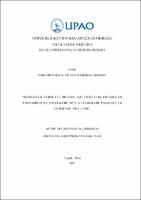| dc.contributor.advisor | Castañeda Sabogal, Alex | |
| dc.contributor.author | Geldres Molina, Fernando | |
| dc.creator | Geldres Molina, Fernando | |
| dc.date.accessioned | 2018-04-04T23:57:45Z | |
| dc.date.available | 2018-04-04T23:57:45Z | |
| dc.date.issued | 2017 | |
| dc.identifier.uri | https://hdl.handle.net/20.500.12759/3880 | |
| dc.description.abstract | Introducción El tratamiento antirretroviral ha conseguido mejorar enormemente la esperanza de vida de los pacientes con VIH SIDA, sin embargo estos medicamentos a largo plazo pueden producir efectos adversos sobre el perfil lipídico aumentando la morbimortalidad cardiovascular. Este estudio busca comparar los efectos sobre los lípidos de dos de los principales medicamentos usados en nuestro país. Métodos Se realizó un estudio de cohorte retrospectiva, en el cual se comparó el perfil lipídico de pacientes recibiendo efavirenz (EFV) versus atazanavir (ATV) con un esqueleto de base de zidovudina y lamivudina durante un periodo de seguimiento de 36 meses. Usamos la prueba t de student para determinar diferencias en las medias del perfil lipídico en pacientes recibiendo los diferentes esquemas. Resultados Se incluyeron 212 pacientes que recibieron tratamiento antirretroviral entre 2005 y 2016, de los cuales 135 estaban recibiendo EFV y 74, ATV. La edad promedio fue 39.97 años. La prevalencia basal de dislipidemia fue 72% y el hallazgo patológico más frecuente fue elevación del LDL. El incremento medio de HDL del basal a los 36 meses fue significativamente diferente entre ambos grupos, teniendo un incremento mayor los pacientes que recibieron ATV en comparación a EFV (8.33 vs. 4.26, respectivamente p<0.01). Se encontró una diferencia importante en el cambio de los TG desde el basal a los 36 meses comparando ATV con EFV, con una disminución de 19.06 en los pacientes con ATV y un aumento de 40.62, con EFV. (p<0.001). La diferencia de medias en el cambio de CT y LDL fue no significativa entre ambos esquemas de tratamiento. (p=0.32 y p=0.95, respectivamente.) Conclusiones La prevalencia de dislipidemia en pacientes con VIH SIDA que iniciaron tratamiento fue de 72%. Se observaron cambios más favorables en el perfil lipídico en los pacientes que usaron ATV en comparación a EFV a nivel de TG y HDL no observándose diferencias en el CT y LDL. Este beneficio podría asociarse a una disminución del riesgo cardiovascular a largo plazo, lo cual amerita estudios posteriores. | es_PE |
| dc.description.abstract | Background Antiretroviral treatment has greatly improved the life expectancy of patients with AIDS, however, these drugs can produce long term adverse effects, especially disturbances in blood lipids which increase cardiovascular morbidity and mortality. This study seeks to compare the effects on lipids of two of the main antiretrovirals used in our country. Methods A retrospective cohort study was conducted in which the lipid profile of patients receiving efavirenz (EFV) versus atazanavir (ATV) was compared with a zidovudine + lamivudine backbone during a 36-month follow-up period. We use the t student test to determine differences in the lipid profile means in patients receiving the different schemes. Results We included 212 patients who received antiretroviral treatment between 2005 and 2016, of which 135 were receiving EFV and 74, ATV. Their median age was 39.97. The baseline prevalence of dyslipidemia was 72% and the most frequent pathological finding was the elevation of LDL. The mean HDL increase of the baseline at 36 months was different between the groups with EFV and ATV, with the group of patients in treatment with ATV having a greater increase compared with EFV (8.33 vs. 4.26, respectively p <0.01). An important difference was found in the change of TG from baseline to 36 months comparing ATV with EFV, with a decrease of 19.06 in patients with ATV and an increase of 40.62 in those who received EFV. (p <0.001). The mean difference in the change of CT and LDL between both treatments was unsignificant (p=0.32 and p=0.95, respectively). Conclusions The overall prevalence of dyslipidemia in patients with HIV AIDS who started treatment was 72%. EFV-containing regimens were associated with more favorable changes in levels of TC and HDL than ATV-containing regimens. This benefit could be associated with a reduction in long-term cardiovascular risk, which warrants further studies. | en_US |
| dc.description.uri | Tesis | es_PE |
| dc.format | application/pdf | es_PE |
| dc.language.iso | spa | es_PE |
| dc.publisher | Universidad Privada Antenor Orrego - UPAO | es_PE |
| dc.relation.ispartofseries | T_MED.HUMA_2258 | |
| dc.rights | info:eu-repo/semantics/openAccess | es_PE |
| dc.source | Universidad Privada Antenor Orrego | es_PE |
| dc.source | Repositorio Institucional - UPAO | es_PE |
| dc.subject | Perfil lipídico | es_PE |
| dc.subject | Terapia antirretroviral | es_PE |
| dc.subject | VIH | es_PE |
| dc.title | Niveles de perfil lipídico en pacientes con VIH-SIDA en tratamiento con efavirenz y atazanavir. EsSalud. La Libertad. 2005 - 2016 | es_PE |
| dc.type | info:eu-repo/semantics/bachelorThesis | es_PE |
| thesis.degree.level | Título Profesional | es_PE |
| thesis.degree.grantor | Universidad Privada Antenor Orrego. Facultad de Medicina Humana | es_PE |
| thesis.degree.name | Médico Cirujano | es_PE |
| thesis.degree.discipline | Medicina Humana | es_PE |

